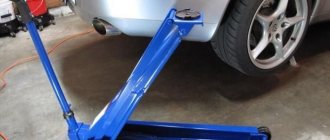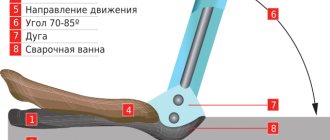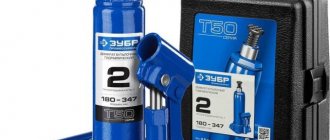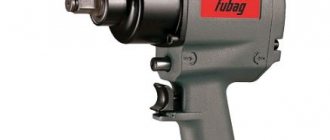A hydraulic jack allows car owners to quickly and safely change a damaged wheel on their car.
To do this, every car must have a jack, since the need to replace a wheel can arise at any time and anywhere on the road. Hydraulic jacks vary in load capacity, weight, dimensions, design, pick-up height and lifting height. In this article we will consider in detail the structure, operating principle, and technical characteristics of hydraulic jacks. Here are the most popular models by load capacity.
Purpose of a hydraulic jack
The main purpose of a jack is to lift and secure a heavy load to a small height. A hydraulic jack uses an incompressible fluid that is forced into a hydraulic cylinder using a hydraulic pump. Oil is most often used as a working fluid. This design of the hydraulic jack allows it to work with very heavy loads.
Hydraulic jacks are not intended for moving loads or holding loads suspended for long periods of time. To do this, after lifting the load to the required height, it is necessary to install additional supports on which the load will be supported. Without such supports, you cannot work under a load to avoid injury.
Classification of jacks
- Mechanical - work from the application of human force (rotating a handle or pressing a lever).
- Hydraulic - work due to a hydraulic mechanism.
- Pneumatic - allow you to lift a load by filling a special cushion with air. Industrial models are equipped with a compressor, domestic ones are connected to the exhaust pipe and filled with vehicle exhaust gases.
- Electrohydraulic - connected to the electrical network, which drives the hydraulic pump.
- Electro-pneumatic - they are connected to electricity, for example to a car cigarette lighter, due to which air is pumped into the pillow.
How to choose a good jack
Very often, users choose a car jack according to typical preferences, bypassing design nuances, and also, in a number of cases, even load-carrying capacity parameters. It is worth noting that this approach does not at all guarantee that the model you choose will be able to serve for a long time and become a reliable element in your personal toolkit. In this regard, the Expertology magazine recommends paying attention to the following criteria:
- Load capacity
. The first and main aspect of the choice, which should be treated with great care. When choosing a jack, be sure to estimate the actual weight of your vehicle (taking into account additional things in the trunk, car interior, etc.) and then proceed from the resulting figure. In general, screw jacks designed for a weight of 1.5 to 3 tons are suitable for passenger cars. For SUVs, rolling (for service stations) or bottle jacks with a lifting capacity of 3-8 tons are ideal. Everything that has indicators above these numbers is an option for trucks. - Pickup height.
This parameter is one of the most underestimated, and, in fact, the most important after the actual mass lifted. It is determined by the vehicle's ground clearance, which should be taken as a standard. In this regard, owners of SUVs and trucks will experience the least problems, the ground clearance of which allows them to easily place rolling, bottle, rack and other types of jacks (with a lifting height of more than 150 millimeters) under the bottom (on the side members). However, if the car is a passenger car and the ground clearance does not exceed 150 millimeters, then the most likely options here will be only screw and roll-on models. - Lifting height
. A characteristic showing to what height from the fulcrum the jack is capable of lifting the planned load. The range of variation here is from 300 to 500 millimeters, and this height is often sufficient to replace a wheel or carry out other repair work. If it is necessary to obtain more significant lifting heights, the purchase of rack and pinion jacks should be considered. These models are capable of lifting a car up to 1000 millimeters above the ground and are used primarily for off-road driving.
Application of hydraulic jacks
- Hydraulic jacks are widely used in professional car repair shops and tire shops, as well as by owners of jeeps and heavy SUVs. Passenger car owners most often prefer compact mechanical jacks.
- Due to their high load capacity, hydraulic bottle jacks are used in the repair of heavy cargo and agricultural equipment, and in industrial production for lifting super-heavy metal structures.
- In construction for lifting heavy blocks, parts of buildings, tensioning reinforcement using reinforced concrete.
- When laying oil and gas pipelines.
- When carrying out rescue operations and liquidation of consequences of accidents.
Which jack is better: screw, bottle or rolling jack?
| Type of jack | Advantages | Flaws |
| Screw | + Low weight of the structure + Lowest price in the segment + Possibility of picking up cars with low ground clearance (from 95-100 mm) + High rigidity of the diamond frame | – Low stability due to narrow support foot – Possibility of the propeller breaking at the top point of lifting – Low load capacity – Uneven distribution of forces on the handle |
| Bottle | + Good load capacity + Ease of manipulation (force is transmitted through the pumping lever) + High degree of stability due to wide support heel + Average cost level | – The need for periodic maintenance (cleaning off contaminants, checking seals and opening valves) – Inability to pick up low-clearance vehicles – Destruction of seals over time and, as a result, oil leakage with the need for periodic topping up |
| Roll-up | + Huge variety of drive mechanisms (pneumatic, hydraulic, mechanical, etc.) + High degree of stability + Low profile and low initial pickup level + High structural rigidity + Uniform power transmission | – Highest cost in the segment – Large weight and dimensions of the structure – The need to place only on flat surfaces (due to the possibility of skew) |
Bonus: How to use your jack safely and extend its lifespan
It’s not enough to choose the right one; it’s also important to use the jack correctly.
- Choose the lifting height depending on the purpose: to remove the wheel, it is enough for it to come off the ground; to inspect the suspension, you need to lift the car even higher.
- The jack can only be placed on a flat, hard surface: concrete, asphalt. Then the lift will not move and the machine will not fall from the support. Be sure to place chocks under the wheels that will remain on the ground.
- The jack is only used for lifting, not for support: do not leave the vehicle on it. After lifting to the desired height, place safety stands under the car - now you can work!
- On many cars, the location for installing the jack is indicated by arrows. If there are no signs, carefully read the vehicle's operating instructions - there should be information there
What you should absolutely not do:
- Do not place a jack under the bottom of the car: the metal there is not so strong and the bottom can be damaged.
- Do not install a lifting device under moving parts of the machine, such as suspension.
How to extend the life of a jack?
Over time, the stroke of the jack rod becomes less smooth, and the machine rises jerkily, the lifting speed decreases, and more physical force has to be applied. These are the first “symptoms” of problems - it is better not to let them get to you and service the jack in a timely manner.
For rhombic and rolling jacks, it is necessary to lubricate the rubbing metal parts with grease to reduce wear, and it is also important to clean them from dirt. Store the device in a dry place to prevent rust. Inspect the rolling jack periodically for oil leaks. If the rivets are loose, the screws or levers are damaged, don’t risk it and buy a new jack.
If the hydraulic jack is used incorrectly (for example, you do not remove dirt from the rod in a timely manner), the seals will be damaged, and as a result, oil will leak out and will have to be topped up. If the oil is contaminated, it must be changed completely.
The efficiency of operation is also affected by the appearance of air bubbles in the hydraulic cylinder: to release them, open the bypass valve and the oil filler cap, and then quickly press the handle several times to release excess air.
Rating of the best car jacks
| Nomination | place | Name of product | price |
| The best rolling jacks | 1 | WIEDERKRAFT WDK-81885 | 12 052 ₽ |
| 2 | Matrix 51040 | 5 024 ₽ | |
| 3 | KRAFT KT 820003 | 3 230 ₽ | |
| 4 | SKYWAY S01802005 | 2 519 ₽ | |
| The best bottle jacks | 1 | Kraftool 43463-6 | 2 713 ₽ |
| 2 | AIRLINE AJ-TB-12 | 3 899 ₽ | |
| 3 | AUTOPROFI DG-08 | 1 476 ₽ | |
| 4 | Bison 43060-12 | 1 649 ₽ | |
| The best rack and pinion jacks | 1 | SKYWAY S01803005 | 5 409 ₽ |
| 2 | MATRIX 505155 | 3 549 ₽ | |
| The best screw jacks | 1 | AUTOPROFI DV-15R | 960 ₽ |
| 2 | KRAFT KT 800025 | 830 ₽ | |
| 3 | Airline AJ-R-02 | 969 ₽ | |
| 4 | BELAVTOKOMPLEKT TANK.00058 | 749 ₽ | |
| Best inflatable jack | 1 | AIR JACK 3 tons | 6 310 ₽ |
Jack for a passenger car - popular models
Mechanical models are the least convenient, but the most reliable. They require minimal maintenance, but are capable of performing tasks that even the most modern automation cannot do.
Rack jack
This can lift a car to a maximum height of more than a meter. This indicator depends solely on the length of the rail. For this reason, rack and pinion jacks are recommended to owners of SUVs who use their vehicles for their intended purpose: you can definitely use it to push the car out of a rut or change a tire far from the city.
In other cases, there is no point in using the rack and pinion model. It is not very compact: a meter-long one will hardly fit into the trunk of a car. And it’s not very convenient - after all, when lifting the car you will have to work with your hands.
Diamond jack
The cheapest and simplest manual option. To activate it, you need to rotate the handle. The lead screw compresses the rhombic structure and lifts the working platform, and with it the side of the car.
Advantages of a mechanical screw jack: compactness, light weight and low price. But it cannot be called a champion in terms of carrying capacity and ease of use. The “thin spot” of all models is the lead screw, which often threatens to crumble into crumbs even at the first use. Often the upper platform also does not hold up - it folds during the lifting process. Therefore, when choosing such a model, the carrying capacity should be greater: it is better to take a device that can withstand 500–800 kg more than the weight of the car.
Bottle jack
A device with a hydraulic mechanism will lift both a crossover and an SUV. It is compact, with a retractable rod, which becomes a support when lifting the car. If the vehicle clearance is low, you can choose a single-rod mechanism. If you need maximum lifting height, you should give preference to a two-rod jack.
Another advantage of the model is its compactness; the device takes up minimal space in the garage and trunk. But when using it, you should be careful: on a soft base, bottle models are unstable and easily “burrow” into the ground. They should only be placed on asphalt. Over time, the power reserve of a telescopic jack is lost and becomes smaller, and if the device malfunctions, it is unlikely to be restored; you will have to buy a new one.
pixabay.com/
Rolling jack
An ideal choice for use in the garage, but it is unlikely to be suitable as an “emergency aid” device: rolling devices are bulky and take up too much space in the trunk. On a long trip you can take only the most compact one with you, but this is used only for passenger cars; it will no longer cope with a crossover.
Roll-away models are hydraulic, which makes them convenient for stationary use. And they are stable, so they can be used both on solid ground and on the ground.
The best rolling jacks
WIEDERKRAFT WDK-81885
Rating: 4.9
Low-profile jack made in Germany, designed for use at service stations and car inspection points. It has two working cylinders, which increases the reliability of the moving part and allows you not to worry about a possible breakdown. It has a carrying capacity of 3 tons, slightly increasing the variety of vehicles serviced.
Having dimensions of 640×342×174 millimeters, WIEDERKRAFT WDK-81885 provides lifting of the serviced vehicle (or other large cargo) to a height of up to 455 millimeters, which is a good result, especially for low-profile jacks. The only weak point identified by consumers was the mass parameter: moving 34 kilograms of metal in space is a rather difficult task. In other aspects, this model is above all praise, justifying the price tag with excellent performance.
Advantages
- optimal cost level;
- low profile, allowing you to organize pickup of cars with low ground clearance;
- two hydraulic cylinders in the working part;
- high quality components.
Flaws
- heavy weight of the product (34 kilograms).
Operating principle of a hydraulic jack
The operation of a hydraulic jack is based on the constancy of fluid pressure in communicating vessels. Inside the jack there are two “vessels” connected to each other. One vessel is the main cylinder with a working plunger, the other is a cylinder with a discharge plunger. This hydraulic system is filled with technical oil.
The injection cylinder is connected to an oil reserve tank and a lever. When the lever is pressed, the injection plunger moves: it lowers and pushes the oil out of the injection cylinder. The oil passes into the main cylinder and pushes the working plunger upward, due to this the load located on the jack’s support platform is lifted.
As a result of each press of the lever, a certain volume of oil is pumped into the main cylinder, equal to the volume of the injection cylinder. The discharge cylinder is filled with oil from the reservoir. Since pressing the lever alone is not enough to lift the load, they usually continue to move the lever until the desired height is reached.
Between the discharge and main cylinders there is a valve that allows fluid to flow in only one direction and prevents it from returning back to the discharge cylinder. The walls of the main cylinder must be designed for the weight of the load being lifted.
After reaching the desired lifting height, the jack must be returned to its initial position; to do this, it is necessary to open the bypass valve. The oil from the main working cylinder will return to the oil reserve tank and the jack will lower.
The best bottle jacks
Kraftool 43463-6
Rating: 4.9
A six-ton bottle jack, which is a bestseller among SUV and small truck owners. It is a very durable tool, made from a high-quality selection of materials - from the body to the hydraulic cylinder and piston part. Provides vehicle pickup at a level of 170 millimeters, which is acceptable even for a number of passenger cars. The peak lifting height is limited to 420 millimeters, which is quite sufficient for hanging a wheel and carrying out work under the body.
Despite such impressive operating parameters, the structural weight of Kraftool 43463-6 is not sky-high - the device in working condition weighs no more than 5 kilograms. And in terms of price, let’s be honest, this model seems to be the most affordable on the market, leaving its closest analogues out of business.
Advantages
- optimal balance of own weight and load capacity;
- good lift horizon (up to 420 millimeters);
- ensuring car pickup at the level of 170 millimeters;
- high quality components.
Flaws
- not detected.
AIRLINE AJ-TB-12
Rating: 4.8
The more durable analogue of the AUTOPROFI DG-08 jack surpasses it in almost all relevant comparison parameters, for which it achieves the coveted second place in the ranking of the best. Its carrying capacity is almost 12 tons, which allows it to tow not only small trucks and SUVs, but also to hang loaded bodies. The lift height at the peak is 500 millimeters, but the entire cylinder stroke is limited to 270 millimeters. In other words, the AIRLINE AJ-TB-12 pick-up point is located at 230 millimeters, which automatically prevents the trouble-free use of the jack with some cars.
Another important feature of the model is that with such a high load capacity, its own weight is only 9.5 kilograms. On the one hand, this is very good, since this jack is more suitable for comfortable use and transportation. But on the other hand, this same nuance may turn out to be critical in the case of lifting the maximum calculated load - minor mechanical damage can lead to inevitable breakage of the piston and collapse of the AIRLINE AJ-TB-12 profile.
Advantages
- optimal lifting height (500 mm);
- ability to handle up to 12 tons of load;
- good ergonomics (mainly due to low weight);
- low price.
Flaws
- low weight can cause the jack to break if the maximum load is applied for a long time.
Hydraulic jack device
The hydraulic jack consists of the following elements:
- Frame . The body is made of hardened steel and can be short or long. The housing contains a cylinder with a piston.
- The base of the body is the base on which the jack rests during operation.
- The catch is the uppermost part of the piston, which rests on the load being lifted. It is made of high-strength steel and has a corrugated surface to prevent the load from sliding. It is often equipped with a height-adjustable nozzle, which allows you to place a mechanical initial emphasis on the load without affecting the hydraulics.
- Pressure gauge . Allows you to monitor developing pressure.
- Reserve container in which the working fluid is located. Using a lever system, liquid is forced from the reserve tank into the discharge cylinder, and then into the main one.
- Working fluid . Most often, special hydraulic oils are used as the working fluid in hydraulic cylinders. It is not recommended to fill the hydraulic cylinders with water or brake fluid, as they will cause corrosion of the internal metal elements, which will lead to rapid failure of the jack.
- Oil filter . Needed to clean oil from contamination.
- Main cylinder with plunger. The rise of the plunger is due to the flow of working fluid into the cylinder, the lowering of the plunger occurs when the fluid flows into the reserve tank.
- Discharge cylinder with plunger . Pumps oil into the main working cylinder.
- Inflation valve. Allows fluid to flow from the discharge cylinder into the main cylinder and blocks its reverse movement. That is, it is responsible for the movement of the working fluid in only one direction, preventing its return.
- Pressure relief valve (bypass valve) . After reaching the desired height, the jack must be returned to its original state. To do this, there is a valve that allows the oil to return to the reserve tank and relieve pressure. This valve is needed to drain excess fluid and prevent the jack from being overloaded.
Best inflatable jack
AIR JACK 3 tons
Rating: 4.7
In the not-too-distant past, the Air Jack was just a prototype of a new type of jack being tested for effectiveness under a variety of operating conditions. However, today this pneumatic model is the most rational tool for off-road adventures, which is not afraid of sand, snow, clay and dirt. Thanks to the ability to adapt to the terrain of the ground, Air Jack does not have the disadvantages characteristic of jacks with a small support heel: they do not sag, getting stuck in the ground in parallel, and are not subject to distortion, which can cause the car to fall off.
An important advantage of this model is the ability to lift the car even from a 20-mm clearance without the need to dig and deepen the installation site. At the same time, the car can be “lifted” up to a height of 700 millimeters, which eliminates the need to use heavy rack and pinion jacks. As a result, the model has a huge number of advantages, but in fairness it is worth noting that the Air Jack manufacturing technology is not yet stable enough.
Advantages
- the ability to pick up a car at a height of 20 millimeters;
- wide supporting surface, eliminating the possibility of the jack falling into unstable soil;
- 700 millimeters of rise;
- virtual absence of distortions.
Flaws
- instability of manufacturing technology (there are many defective products).
Before we talk about jacks, we need to define some terms.
- Jack lifting capacity.
This is a characteristic that indicates how much mass, what load, the jack can lift. - The lifting height of a jack
is the minimum height of the jack from which it can begin to lift a load, that is, the height from the ground to the top of the jack in its complex state. - The lifting height of a jack
is the maximum height to which a jack can lift a load.
These are very important characteristics. The jack is usually selected based on these data. Where can I find this data? There are technical characteristics of the car that may be indicated there. If not, you can look for data on the Internet. But usually such data is published by enthusiasts, and it’s up to you to trust them or not.
Selection criteria: how to choose the right tool
Criteria for choosing a hydraulic product
Which car jack should you choose instead of the standard one or in addition to it? There really is no universal option. Suffice it to say that a jack with a lifting capacity of 3 tons, which suits the owner of a sedan, will almost certainly not suit someone who drives an SUV.
According to the type of drive, professional aluminum jacks are divided into manual (mechanical or hydraulic), electric and pneumatic (it is connected to the exhaust pipe). They can also be classified and used according to the design of the actuators: rhombic and rolling, bottle (screw and hydraulic) and rack and pinion, lever-screw and “cushion” type.
FAQ
Why does the jack not hold the load after lifting the car? The fact is that the jack is not designed to hold the load for a long time - it should only lift it. If you need to hold something heavy for a long time, it is better to use supports. In addition, the weight of the load may exceed the lifting capacity of the jack. Finally, the tool may simply be faulty, so if you doubt it, it is better to diagnose it.
How to fill oil into a hydraulic jack? Filling the oil varies slightly from model to model, so it's best to check your jack's manual. In general terms, this is done like this:
- open the exhaust valve and lower the jack completely;
- open the filler hole located on the bottom (for rolling jacks) or a third below the top (for bottle jacks);
- pour oil into the hole up to the neck (here it is better to use a funnel);
- close the filler hole;
- We bleed the air from the system by fully raising and lowering the jack two or three times.











